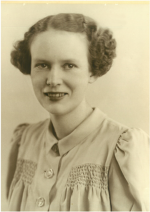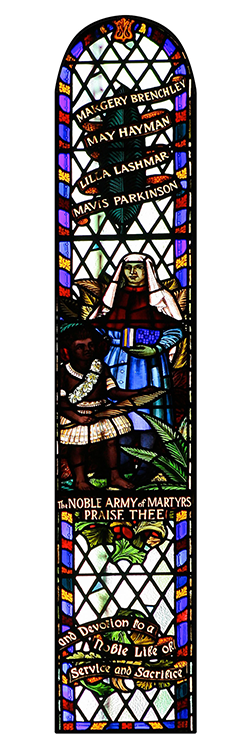ABM Archive Website
THIS WEBSITE CONTAINS ARCHIVE MATERIALS FOR HISTORICAL REFERENCE ONLY
For up-to-date information, including our latest appeals, news, and resources, please visit our current website.
Brisbane Event: St John’s Cathedral launches Martyrs book
November 20, 2018

St John’s Cathedral in Brisbane will be launching a new book ‘Anzac Legend’ which is about the various war memorials and treasures in the Cathedral dating back to World War I.
One of the memorials at St John’s Cathedral is a stained glass window of Mavis Parkinson, one of the 12 Anglican missionary martyrs who died in Papua New Guinea during the occupation of Japanese forces in 1942-43.
The book will be officially launched at the Cathedral by His Excellency Governor Paul de Jersey AC at 7:00pm on 19 December, 2018. It will be distributed to Brisbane secondary schools and complimentary copies will be available at the event.
If you are interested in attending the launch, please RSVP to Lisa Clarke on (07) 3835 2239 or email lclarke@stjohnscathedral.com.au
(The following article was written by Denzil Scrivens)
Cathedral launches new book on the New Guinea Martyrs
As Australians have been commemorating the end of the First World War, St John’s Cathedral in Brisbane is preparing to debut a comprehensive book on the many priceless memorials which have been entrusted to the Cathedral’s safekeeping in memory of the “Anzac Legend” and sacrifices in war made by ordinary Australians throughout the past 100 years.
Thanks to the support of the Queensland Government, together with the resources of the Australian War Memorial in Canberra, this insightful and evocative book will be launched at the Cathedral by the Governor of Queensland on Wednesday 19 December at 7:00 pm.
The date of the launch marks the 103rd anniversary that the Cathedral’s Gallipoli flag was flown at Anzac Cove, recently discovered to have been the last flag flown at the evacuation of the Anzacs on 19 December 1915.
 |
| Window in St John’s Cathedral com- memorating the New Guinea Martyrs. |
Of interest to ABM supporters is another memorial featured in the book. This is a stained glass window in the South Transept of the Cathedral which depicts a nurse standing next to a Papuan in native dress. The window commemorates the four women missionaries who were killed in Papua in 1942 when the Australian territories of Papua and New Guinea were invaded by the Japanese. The inclusion of their names in the Cathedral window is a reminder of the sacrifice and devotion to duty that these Australian missionary workers displayed when the Japanese invaded.
The four women mission workers were part of a larger group of Australian missionaries in Papua and New Guinea who were working as priests, medical workers, nurses and teachers when the Japanese invaded. As the Japanese advanced towards New Guinea the Bishop of New Guinea and later Archbishop of Brisbane, the Right Reverend Philip Strong, broadcast a message to the missionaries urging them to remain in their posts. He told them:
“…we must endeavour to carry on our work in all circumstances, no matter what the cost may ultimately be to any of us individually…Our people need us now more than ever before in the whole history of the Mission… we cannot leave. We shall not leave. We shall stay by our trust. We shall stand by our vocation”
The missionaries remained, a decision which sealed the fate of a number of them who were to meet their death at the hands of the invaders. The first to die was the Reverend Henry Mathews of Port Moresby, a Victorian cleric who was well over 60 years of age. He was killed, either shot or drowned, in a boat in which he was carrying a group of local people to safety. Killed with him was his faithful Papuan helper, Leslie Gariadi of Boianai.
Shortly afterwards Japanese forces rounded up other missionaries who were trying to flee to safety. The Reverend Henry Holland, John Duffill, Sister Margery Brenchley and Lilla Lashmar, missionaries from Sangara and Isivita, were taken to the coastal village of Buna and executed on the beach. Lucian Tapiedi, a Papuan teacher, who was with them was murdered at the same time by his own people when he stood up for the missionaries.
Another missionary, the Reverend Vivian Redlich, was for many years also thought to have died at Buna but more recently it was revealed that he had been hiding in a bush hut near Sangara before being speared and buried by local Papuans who perhaps feared Japanese reprisals.
Two further missionaries from nearby Gona, Sister May Hayman and 27 year old Mavis Parkinson from Ipswich in Queensland (pictured above), were also killed. They had retreated into the jungle along with a group of other Australians, Americans and Papuans but some time later were betrayed to the Japanese. After refusing to reveal any information during interrogation, they were taken to a coffee plantation where shallow graves were dug. One of the soldiers tried to embrace Parkinson; when she fought him, he plunged his bayonet into her side. Another soldier bayoneted Sister Hayman in the throat. Then their bodies were thrown into the graves. Also bayoneted was a local student who had tried to protect them.
The last of the missionaries to die was the Reverend John Barge, a medical worker specialising in tropical diseases, who was killed in New Britain, off the coast of New Guinea, in October 1943.
Australian and American forces eventually cleared the occupiers from Papua and New Guinea in a campaign that lasted from 1942 to the Japanese surrender in 1945, a campaign which saw the loss of over 7,000 Australian servicemen There were many fierce battles in the campaign, including the infamous engagement along the 96 kilometre long Kokoda track in Papua where Australians fended off the Japanese with great fortitude and endurance, fighting in thick jungle in tropical humidity, mud and heavy rain.
In bitter, deadly fighting, Australian and U.S. troops also retook the coastal villages of Gona and Buna where many of the missionaries had died. The fighting had been particuarly intense around the Gona Mission which the Japanese had transformed into a heavily fortified encampment, even using the decomposing bodies of their own dead soldiers to construct earthworks. After heavy casualties on both sides, the Mission was eventually retaken.
The bodies of Mavis Parkinson and Sister May Hayman were later re-interred at the Anglican Mission in Sangara. In 1948 a school was established at Sangara named in honour of the murdered Anglican missionaries who became known as the “New Guinea Martyrs”. The school moved to Popondetta following a volcanic eruption of nearby Mount Lamington in 1951.
The stories of the Anglican Martyrs and the military campaign to retake New Guinea is relayed in the new book to be launched at St John’s Cathedral on 19 December. Hard copies of the book will be distributed to Brisbane secondary schools and all schools will be able to access the book online via the Cathedral’s website.
ABM supporters who are in Brisbane on the 19 December are warmly invited to attend to the launch. Complimentary copies of the book will be available at the event.


